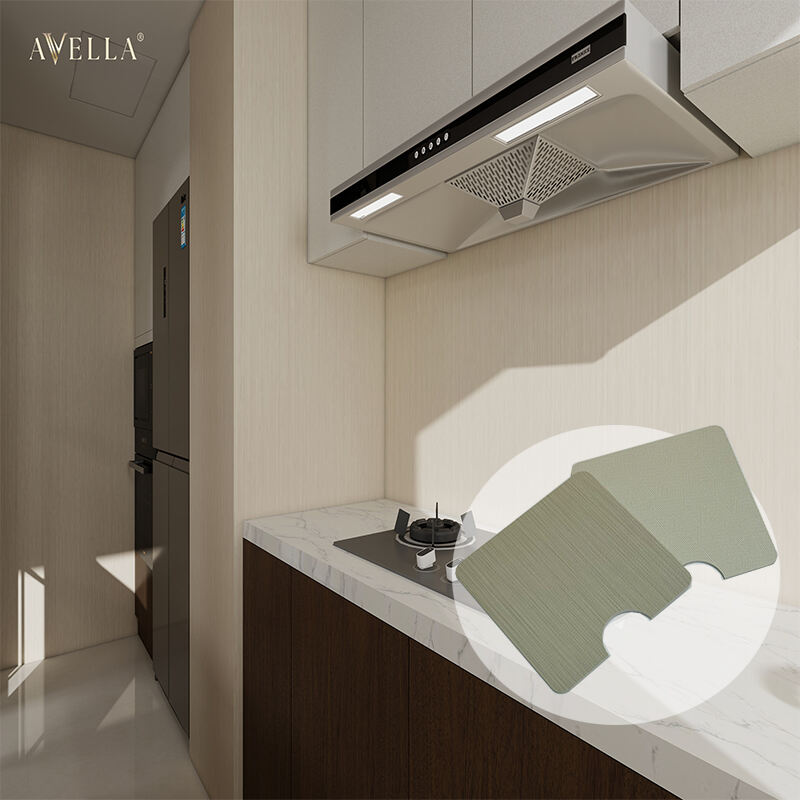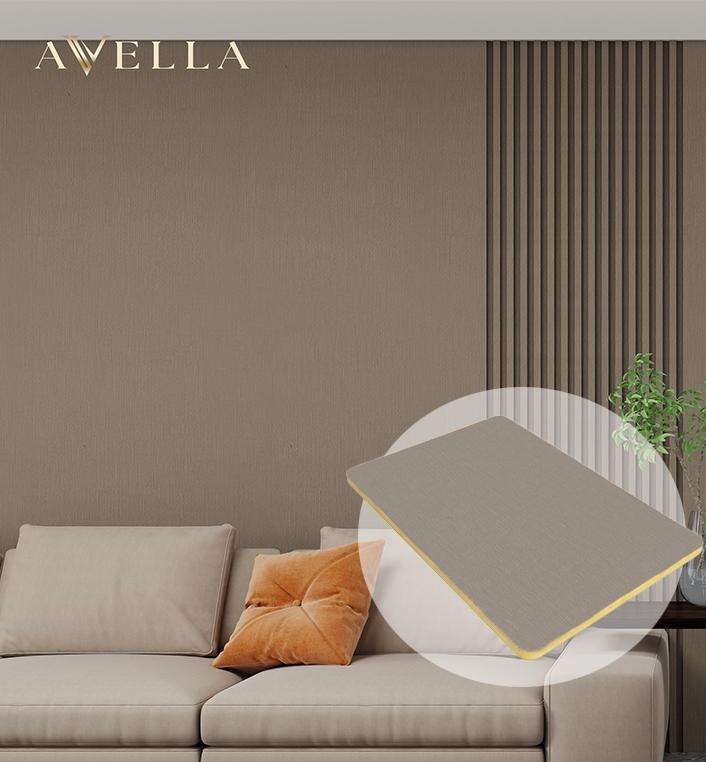Stone Plastic Composite-teknologi har revolusjonert innredningsdesign og bygging, og tilbyr utenkelig holdbarhet og estetisk appell for moderne rom. SPC-veggpanelet representerer en betydelig fremgang innen løsninger for veggbekledning, ved å kombinere den naturlige skjønnheten av steinteksturer med de praktiske fordelene til sammensatte materialer. Disse innovative panelene har vunnet stor popularitet blant arkitekter, designere og huseiere som søker premium veggbelegg som gir både ytelse og visuell innvirkning.

Byggebransjen har sett imponerende innovasjoner de siste årene, med komposittmaterialer i spissen for denne omvandlingen. Tradisjonelle veggbelegg klarer ofte ikke å måle opp til kravene i krevende miljøer, og lider ofte av fuktskader, slitasje og begrenset designfleksibilitet. Moderne komposittløsninger takler derimot disse utfordringene samtidig som de gir bedre funksjonalitet og estetisk mangfold som møter dagens krav til design.
Å forstå de omfattende fordelene og riktige installasjonsteknikkene for disse avanserte veggsystemene er avgjørende både for fagpersoner og eiendomsbesittelere. Denne veiledningen går gjennom de viktigste aspektene ved stein-plast-kompositt-veggteknologi og gir detaljert innsikt i materialeegenskaper, installasjonsprosedyrer og langsiktige ytelsesoverveielser som påvirker prosjekters suksess.
Forståelse av teknologien bak steinplastkompositt
Materialoppbygging og struktur
Stone Plastic Composite-paneler har en sofistikert flerlagskonstruksjon som kombinerer kalksteinspulver, polyvinylklorid og spesialiserte stabilisatorer. Kjernelaget gir strukturell integritet og dimensjonal stabilitet, mens den dekorative overflatelaget leverer autentiske strukturer og mønstre. Denne konstruerte sammensetningen resulterer i paneler som tåler fukt, temperatursvingninger og mekanisk påkjenning bedre enn tradisjonelle materialer.
Produksjonsprosessen innebærer nøyaktig kontroll av temperatur og trykk for å oppnå optimal tetthet og ytelsesegenskaper. Hvert SPC-vegpanel gjennomgår omfattende kvalitetstesting for å sikre konsekvent tykkelse, overflatestruktur og dimensjonal nøyaktighet. Det resulterende produktet viser overlegen holdbarhet samtidig som det beholder lettvikts-egenskaper som forenkler håndtering og installasjonsprosedyrer.
Avanserte overflatebehandlinger forbedrer panelenes motstand mot flekker, skrammer og misfarging, og sikrer langvarig estetisk attraktivitet. Den beskyttende topplaget inneholder UV-bestandige forbindelser som forhindrer fargenedbrytning, selv ved direkte sollys. Disse tekniske spesifikasjonene gjør sammensatte paneler egnet for både innvendige og dekkede utvendige anvendelser under ulike klimatiske forhold.
Ytelsesegenskaper og standarder
Industrielle testprotokoller vurderer sammensatte veggpaneler i henhold til strenge ytelsesmål, inkludert dimensjonal stabilitet, slagfasthet og varmeutvidelseskoeffisienter. Disse standardiserte testene sikrer at produktene oppfyller internasjonale bygningskoder og ytelseskrav. SPC-veggpanelet viser typisk eksepsjonelle resultater i brannmotstandstester, og oppnår ofte klasse A-brannklassifisering som oppfyller kravene i kommersielle bygningsreglementer.
Fuktagringshastigheter forblir minimale på grunn av lukket-celle-strukturen i komposittmaterialet, noe som forhindrer svelling, krumning eller delaminering i miljøer med høy fuktighet. Denne egenskapen viser seg spesielt verdifull i applikasjoner som baderom, kjøkken og kommersielle rom der tradisjonelle materialer ofte svikter før tiden.
Lyddempingsegenskaper til komposittpaneler bidrar til forbedret akustisk ytelse i boliger og kommersielle lokaler. Den tette kjernestrukturen demper effektivt lydoverføring, mens overflatestrukturen kan utformes for å forbedre lydabsorberende egenskaper, og dermed skape mer behagelige innendørs miljøer.
Installasjonsmetoder og beste praksis
Overflateforberedelseskrav
Riktig overflateforberedelse utgjør grunnlaget for vellykket installasjon av sammensatte paneler og krever grundig vurdering av eksisterende veggbetingelser og underlags egenskaper. Installasjonsflaten må være ren, tørr, jevn og strukturelt stabil for å sikre optimalt paneltilheng og langtidsholdbarhet. Eventuelle uregelmessigheter, løs maling eller skadde områder må rettes opp før panelinstallasjonen begynner.
Fuktmåling av underlag blir kritisk i områder utsatt for fuktighet eller potensiell vanninntrengning. Installasjonsgrupper bør bekrefte at fuktinnholdet ligger innenfor akseptable verdier for å unngå fremtidige problemer med tilheng eller skader på panelene. Primer kan være nødvendig på visse underlag for å forbedre tilhengsegenskapene og sikre riktig binding mellom veggflaten og sammensatte paneler.
Temperatur- og fuktighetsforhold under installasjon påvirker i stor grad det endelige resultatet, der optimale forhold vanligvis ligger mellom 65–75 grader Fahrenheit og 30–50 % relativ fuktighet. Disse kontrollerte forholdene gjør at limmidler kan herde ordentlig og forhindrer varmeutvidelsesproblemer som kan kompromittere installasjonsintegriteten.
Mekaniske festemetoder
Mekaniske festesystemer tilbyr pålitelige festemetoder for sammensatte veggpaneler, spesielt i kommersielle anvendelser der økt sikkerhet og holdbarhet er nødvendig. Skjulte festesystemer bevarer den rene utseendet av paneloverflater samtidig som de gir en robust mekanisk forbindelse til veggram eller underlagsmateriale.
Valg av festemidler avhenger av underlagsmateriale og lokale byggforskrifter, med alternativer som spesialiserte skruer, klemmer og skinnesystemer utformet spesielt for sammensatte panelapplikasjoner. Riktig avstand og innboringdybde på festemidler sikrer tilstrekkelig holdkraft samtidig som man unngår skader på panelene eller brudd i underlaget ved belastning.
Kvalitetskontroll under mekanisk installasjon innebærer å verifisere riktig dreiemoment på festemidler, kontrollere panelenes justering og sikre jevn avstand mellom panelene. Faginstallatører bruker spesialiserte verktøy og maler for å opprettholde nøyaktig plassering og oppnå ensartet utseende over store veggflater der visuell konsistens er viktig.
Designapplikasjoner og estetiske betraktninger
Integrering i interiørdesign
Moderne interiørdesign-trender inkluderer økende bruk av sammensatte veggpaneler for å skape sofistikerte rom som balanserer funksjonalitet med visuell appeal. Mangeformålet når det gjelder panelteksturer, farger og mønstre gjør at designere kan oppnå ulike estetiske mål samtidig som de opprettholder praktiske ytelseskrav. Fra boligaccentvegger til kommersielle uttrykksfulle installasjoner, tilpasser disse materialene seg ulike designfilosofier og arkitekturstiler.
Fargekoordinering og teksturval spiller en avgjørende rolle for vellykket designintegrasjon, med paneler tilgjengelig i mange overflater som komplementerer eksisterende innredningselementer. Teksturer som naturlig stein, trestrukturer og moderne geometriske design gir alternativer for både tradisjonelle og moderne designskjema, og sikrer kompatibilitet med ulike prosjektkrav.
Belysningsdesign blir viktig når sammensatte paneler spesifiseres, ettersom overflatestrukturer interagerer ulikt under forskjellige lysforhold. Riktig belysning forsterker den visuelle effekten av strukturerte overflater samtidig som det sikrer at panelelementers skjøter og monteringsdetaljer forblir visuelt tiltalende gjennom ulike tidspunkter på dagen og i forskjellige belysningsforhold.
Kommersielle og boligapplikasjoner
Kommersielle anvendelser av sammensatte veggpaneler omfatter flere sektorer, inkludert hotell- og reiseliv, helsevesen, detaljhandel og kontormiljøer, der holdbarhet og vedlikeholdsaspekter er avgjørende. Evnen til å tåle intens bruk mens utseendet beholdes, gjør disse materialene ideelle for områder med mye trafikk som krever hyppig rengjøring og vedlikehold.
Boliganvendelser drar nytte av enkel vedlikehold og langsiktige ytelsesegenskaper som reduserer behovet for kontinuerlig vedlikehold. Huseiere setter pris på muligheten til å oppnå et premiumutseende uten vedlikeholdsbehovet knyttet til naturlige materialer, noe som gjør sammensatte paneler attraktive for travle husholdninger og fritidsboliger.
Spesialiserte anvendelser som helseinstitusjoner krever materialer som oppfyller strenge hygien- og rengjøringsprotokoller, der spc veggspanel systemer gir porøse overflater som motsetter seg bakterievekst og letter grundig desinfeksjonsprosedyrer som kreves i medisinske miljøer.
Vedlikehold og langtidsprestasjoner
Rengjøringsprotokoller og vedlikeholdsanvisninger
Rutinemessig vedlikehold av sammensatte veggpaneler innebærer enkel rengjøring som bevarer utseendet og forlenger levetiden uten at det krever spesialiserte produkter eller teknikker. Regelmessig støvstøv og periodisk vasking med mildt rengjøringsmiddel opprettholder optimalt utseende samtidig som oppbygging av smuss og forurensninger som kan påvirke overflateintegriteten, unngås.
Flekkfjerningsprosedyrer varierer avhengig av type og alvorlighetsgrad av søling, der de fleste vanlige flekker responderer på vanlige husholdningsrengjøringsprodukter. Den ikke-porøse naturen til sammensatte overflater hindrer dyp inntrengning av flekker, noe som gjør fjerning enklere sammenlignet med tradisjonelle porøse materialer som kan kreve omfattende rengjøring eller nyoverflatebehandling.
Preventive vedlikeholdsplaner bør inkludere periodiske inspeksjoner av panelledd, festemidler og kantforhold for å identifisere potensielle problemer før de krever omfattende reparasjoner. Tidlig oppdagelse av problemer muliggjør enkle korrigerende tiltak som sikrer systemintegritet og utseende over lengre tidsrom.
Vareholdsdyrkhet og Garanti Overveigelser
Produsentgarantier for sammensatte veggpaneler dekker vanligvis materielle feil, fargestabilitet og ytelsesegenskaper i perioder fra 10 til 25 år, avhengig av produktspesifikasjoner og bruksbetingelser. Å forstå garanti vilkår og krav hjelper eiendomseiere med å ta informerte beslutninger om materialvalg og installasjonsprosedyrer.
Langsiktige ytelsesdata viser at riktig installerte sammensatte paneler beholder sin strukturelle integritet og utseende i tiår med minimalt vedlikeholdsbehov. Denne holdbarheten fører til reduserte livssykluskostnader sammenlignet med materialer som krever periodisk oppfrisking, utskifting eller omfattende vedlikeholdsprosedyrer.
Miljøfaktorer som ekstreme temperaturer, fuktighetssvingninger og UV-eksponering har minimal innvirkning på ytelsen til sammensatte paneler når produktene velges riktig for spesifikke bruksforhold. Denne stabiliteten sikrer konsekvent utseende og funksjonalitet gjennom hele den forventede levetiden til installasjonen.
Kostnadsanalyse og økonomiske fordeler
Vurderinger ved initielle investeringer
Kostnadsanalyse for prosjekter med sammensatte veggpaneler må ta hensyn til både opprinnelige material- og installasjonsutgifter, samt langsiktige vedlikeholds- og erstatningskostnader. Selv om premium komposittmaterialer kan kreve høyere førstegangsinvesteringskostnader sammenlignet med enklere alternativer, foretrekkes ofte komposittløsninger når det gjelder totale eierkostnader på grunn av reduserte vedlikeholdskrav og lengre levetid.
Arbeidskostnader for installasjon varierer avhengig av prosjektkompleksitet, underlagsforhold og lokale lønnsnivåer, og profesjonell installasjon anbefales vanligvis for å sikre optimal ytelse og at garantibetingelser overholdes. Effektiviteten til moderne installasjonssystemer kan hjelpe til med å redusere arbeidskostnader ved kortere installasjonstid i forhold til tradisjonelle materialer som krever omfattende overflateforberedelse eller etterbehandling.
Prosjektstørrelse og kompleksitet påvirker enhetskostnadene, der større installasjoner vanligvis oppnår bedre priser gjennom skalafordeler. Planleggingsoverveielser som paneloppsett, minimering av avfall og installasjonsrekkefølge kan betydelig påvirke totale prosjektkostnader samtidig som man sikrer optimale estetiske resultater.
Analyse av inntektsføring
Verdifulle forbedringer av eiendommer representerer en betydelig fordel ved premium veggpanelinstallasjoner, hvor kvalitetsmaterialer bidrar til forbedret markedsføring og høyere omsetningsverdier. Det profesjonelle utseendet og lave vedlikeholdsbehov tiltrekker seg potensielle kjøpere og leietakere, noe som gjør eiendommer mer attraktive i konkurranseutsatte markeder.
Forbedringer av energieffektivitet kan følge av forbedrede veggsystemer som gir bedre termisk ytelse sammenlignet med tradisjonelle materialer. Forbedrede isolasjonsegenskaper kan redusere oppvarmings- og nedkjølingskostnader samtidig som de skaper mer behagelige innendørs miljøer som øker brukertilfredshet og produktivitet.
Reduserte vedlikeholdskostnader fører til betydelige besparelser over tid, ettersom komposittpaneler krever minimalt med vedlikehold sammenlignet med materialer som må males, tettes eller bearbeides regelmessig. Disse kostnadsbesparelsene, kombinert med lengre levetid, resulterer vanligvis i gunstige avkastningsberegninger for både bolig- og kommersielle anvendelser.
Ofte stilte spørsmål
Hva gjør komposittveggpaneler forskjellige fra tradisjonelle materialer
Komposittveggpaneler kombinerer flere materialer i teknisk utformede lag for å oppnå overlegne egenskaper, inkludert fuktbestandighet, dimensjonal stabilitet og forbedret holdbarhet. I motsetning til tradisjonelle materialer som tre eller gipsplater, motstår komposittpaneler krumming, sprekker og nedbryting, samtidig som de beholder en konsekvent utseende over lang tid. Produksjonsprosessen tillater nøyaktig kontroll av materialeegenskaper og overflateegenskaper som naturlige materialer ikke kan oppnå.
Hvor lenge tar installasjon vanligvis for boligprosjekter
Installasjonstidsperspektiv avhenger av prosjektets størrelse, kompleksitet og underlagets tilstand, der typiske rom i boliger vanligvis krever én til tre dager for fullførelse. Riktig overflateforberedelse kan medføre ekstra tid, spesielt hvis eksisterende materialer må fjernes eller underlagsreparasjoner er nødvendige. Faginstallatører kan gi nøyaktige anslag for tidsramme basert på spesifikke prosjektkrav og stedskondisjoner, og dermed sikre realistiske forventninger til prosjektfullførelse.
Hva slags vedlikehold er nødvendig for å bevare panelenes utseende
Regelmessig vedlikehold innebærer periodisk rengjøring med milde rengjøringsmidler og myke kluter for å fjerne støv og overflatesmuss. Årlig inspeksjon av panelledd og festemidler hjelper til med å oppdage potensielle problemer på et tidlig stadium, og ved å unngå sterke kjemikalier eller skrapende rengjøringsverktøy bevares overflatens integritet. De fleste flekker kan fjernes med vanlige husholdningsrengjøringsmidler, og den ikke-porøse overflaten forhindrer dyppenegrasjon av smuss som kan forårsake permanent skade.
Er sammensatte paneler egnet for områder utsatt for fukt
Komposittvegpaneletter presterer godt i miljøer med høy fuktighet takket være sin lukkede cellestruktur som forhindrer vannopptak og dermed svelling eller krumning. Materialene motstår mugg- og soppvekst samtidig som de beholder dimensjonal stabilitet under varierende fuktforhold. Riktige installasjonsteknikker, inkludert bruk av passende tetningsmidler og dampsperrer, sikrer optimal ytelse i bad, kjøkken og andre fuktutsatte områder der tradisjonelle materialer ofte feiler før tiden.

